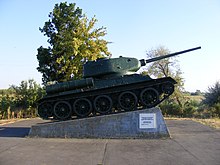
Operation Bagration was the codename for the 1944 Soviet Byelorussian strategic offensive operation, a military campaign fought between 22 June and 19 August 1944 in Soviet Byelorussia in the Eastern Front of World War II, just over two weeks after the start of Operation Overlord in the west, causing Nazi Germany to have to fight on two major fronts at the same time. The Soviet Union destroyed 28 of 34 divisions of Army Group Centre and completely shattered the German front line. It was the biggest defeat in German military history, with around 450,000 German casualties, while 300,000 other German soldiers were cut off in the Courland Pocket.

The Battle of Korsun–Cherkassy, or the battle of the Korsun–Cherkasy pocket, was a World War II battle fought from 24 January to 16 February 1944 in the course of the Soviet Dnieper–Carpathian offensive in Ukraine following the Korsun–Shevchenkovsky offensive.
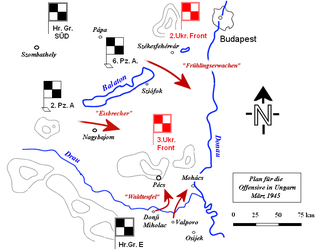
Operation Spring Awakening was the last major German offensive of World War II. The operation was referred to in Germany as the Plattensee Offensive and in the Soviet Union as the Balaton Defensive Operation. It took place in Western Hungary on the Eastern Front and lasted from 6 March until 15 March, 1945. The objective was to secure the last significant oil reserves still available to the European Axis powers and prevent the Red Army from advancing towards Vienna. The Germans failed in their objectives.
Army Group A was the name of three distinct army groups of the Heer, the ground forces of the Wehrmacht, during World War II.

Issa Alexandrovich Pliyev was a Soviet military commander. Pliyev would rise to become the premier cavalry general of the Soviet Army. He became Army General (1962), twice Hero of the Soviet Union, Hero of the Mongolian People's Republic (1971).

The Lvov–Sandomierz offensive or Lvov–Sandomierz strategic offensive operation was a major Red Army operation to force the German troops from Ukraine and Eastern Poland. Launched in mid-July 1944, the operation was successfully completed by the end of August.
The Hungarian Third Army was a field army in the Royal Hungarian Army that saw action during World War II.

The second Jassy–Kishinev offensive, named after the two major cities, Iași ("Jassy") and Chișinău ("Kishinev"), in the staging area, was a Soviet offensive against Axis forces, which took place in Eastern Romania from 20 to 29 August 1944 during World War II. The 2nd and 3rd Ukrainian Fronts of the Red Army engaged Army Group South Ukraine, which consisted of combined German and Romanian formations, in an operation to reoccupy Bessarabia and destroy the Axis forces in the region, opening the way into Romania and the Balkans.
A cavalry-mechanized group was a type of military formation used in the Red Army during World War II against Germany and Japan. It involved a combination of armor and horses.

The 3rd Ukrainian Front was a Front of the Soviet Red Army during World War II.

The Hungarian Second Army was one of three field armies raised by the Kingdom of Hungary which saw action during World War II. All three armies were formed on March 1, 1940. The Second Army was the best-equipped Hungarian formation at the beginning of the war, but was virtually eliminated as an effective fighting unit by overwhelming Soviet force during the Battle of Stalingrad, suffering 84% casualties. Towards the end of the war, a reformed Second Army fought more successfully at the Battle of Debrecen, but, during the ensuing Siege of Budapest, it was destroyed completely and absorbed into the Hungarian Third Army.

The Vienna offensive was an offensive launched by the Soviet 2nd and 3rd Ukrainian Fronts in order to capture Vienna, Austria, during World War II. The offensive lasted from 16 March to 15 April 1945. After several days of street-to-street fighting, the Soviet troops captured the city.
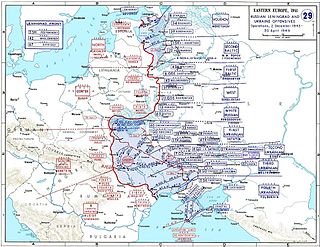
The Dnieper–Carpathian offensive, also known in Soviet historical sources as the Liberation of Right-bank Ukraine, was a strategic offensive executed by the Soviet 1st, 2nd, 3rd, and 4th Ukrainian Fronts, along with the 2nd Belorussian Front, against the German Army Group South, Army Group A and elements of Army Group Center, and fought from late December 1943 to early May 1944. The battles in right-bank Ukraine and in the Crimea were the most important event of the 1944 winter-spring campaign on the Eastern Front.
This order of battle lists the German, Hungarian, Romanian, and Soviet forces involved in the Battle of Debrecen in October 1944.
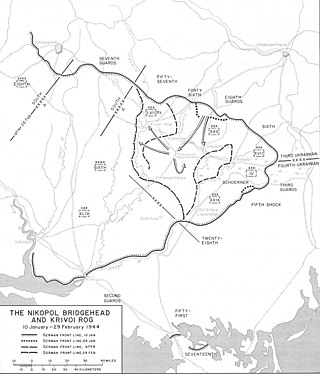
The Nikopol–Krivoi Rog offensive was an offensive by the Red Army's 3rd Ukrainian Front and elements of the 4th Ukrainian Front against the German 6th Army in the area of Nikopol and Krivoi Rog in Dnipropetrovsk Oblast in central Ukraine between 30 January and 29 February 1944. It took place on the Eastern Front of World War II and was part of the wider Dnieper–Carpathian offensive, a Soviet attack against Army Group South to retake the rest of Ukraine that fell to Germany in 1941.
The 53rd Army was a field army of the Soviet Union's Red Army which was formed in August 1941, disbanded in December 1941, and reformed in May 1942. It fought throughout World War II before again being disbanded after the war in October 1945. The army was first formed for the Anglo-Soviet invasion of Iran and was disbanded there in December 1941. The army reformed in May 1942. It fought in the Demyansk Pocket, the Battle of Kursk, the Battle of Belgorod, the Battle of the Dnieper, the Battle of the Korsun–Cherkassy Pocket, the Uman–Botoșani Offensive, the Second Jassy–Kishinev Offensive, the Battle of Debrecen, the Budapest Offensive, and the Prague Offensive. At the end of the war in Europe it was moved to the Far East and fought in the Soviet invasion of Manchuria. The army was disbanded in October 1945.

The Bratislava–Brno offensive was an offensive conducted by the Red Army in western Slovakia and south Moravia towards the end of World War II. The offensive was held between 25 March and 5 May 1945 using the forces of the 2nd Ukrainian Front to capture the capital of Slovakia, Bratislava, and the capital of Moravia, Brno.

Operation Konrad III was a German military offensive on the Eastern Front of the Second World War. It was the third and most ambitious of the three Konrad Operations and had the objective of relieving the siege of Budapest and recapturing the entire Transdanubia region. Achieving complete surprise, the German offensive began on 18 January 1945. Supported by the Luftwaffe, the IV SS Panzer Corps, the principal German attack formation, overran the Soviet 4th Guards Army in two days, destroying hundreds of Soviet tanks along the way, reached the Danube river on 19 January and recaptured 400 square kilometers of territory in four days. After nine days of combat, and the destruction by the SS of two-thirds of Soviet tanks in the entire 3rd Ukrainian Front, the German offensive was stopped by Soviet reinforcements 25 kilometers short of Budapest on 26 January.
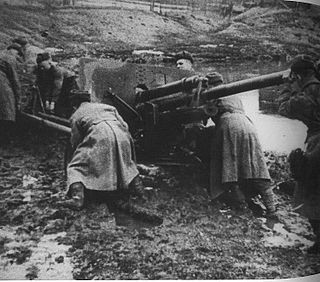
The Bereznegovatoye–Snigirevka offensive was an offensive operation conducted in southern Ukraine by the Soviet 3rd Ukrainian Front against the German 6th Army and Romanian 3rd Army of Army Group A, in March 1944. It was part of the second stage of the strategic Dnieper-Carpathian Offensive.

1st Guards Cavalry-Mechanised Group was a tactical-operational formation of the Soviet Red Army during the Second World War, first serving under the 1st Belorussian Front under the command of Marshal Konstantin Rokossovsky over the course of Operation Bagration, later being transferred to General Rodion Malinovsky's 2nd Ukrainian Front to aid in its offensive into Hungary, Austria and ultimately Czechoslovakia. Commanded by the experienced and talented Guards Lieutenant General Issa Pliev, the Cavalry-Mechanised Group(KMG) proved itself to be an indispensable element of the Red Army in its attempts to destroy the German Wehrmacht on the Belorussian and Ukrainian axes.

